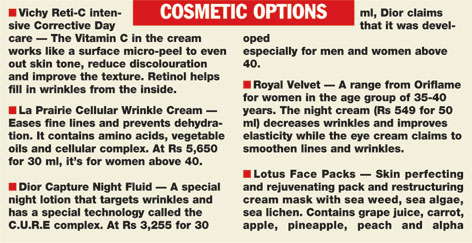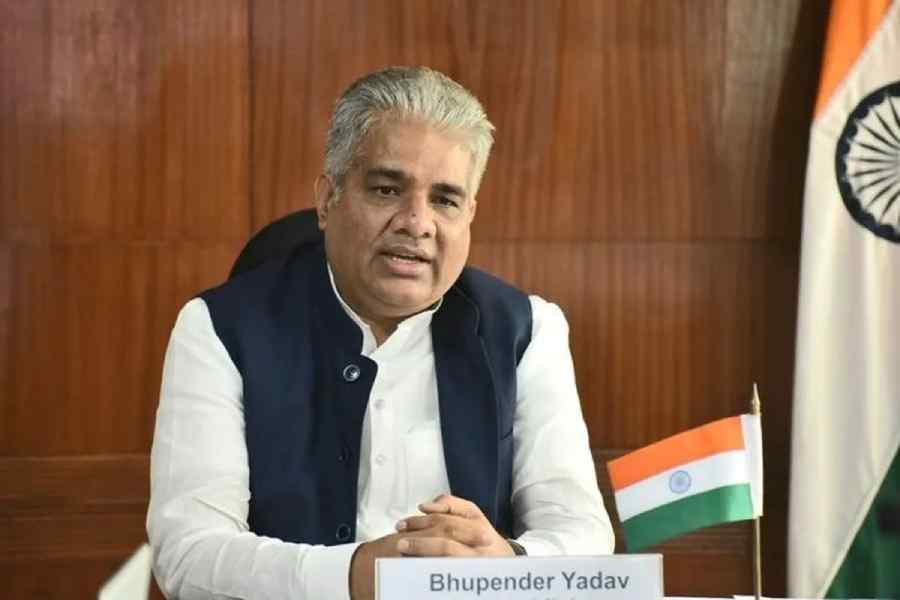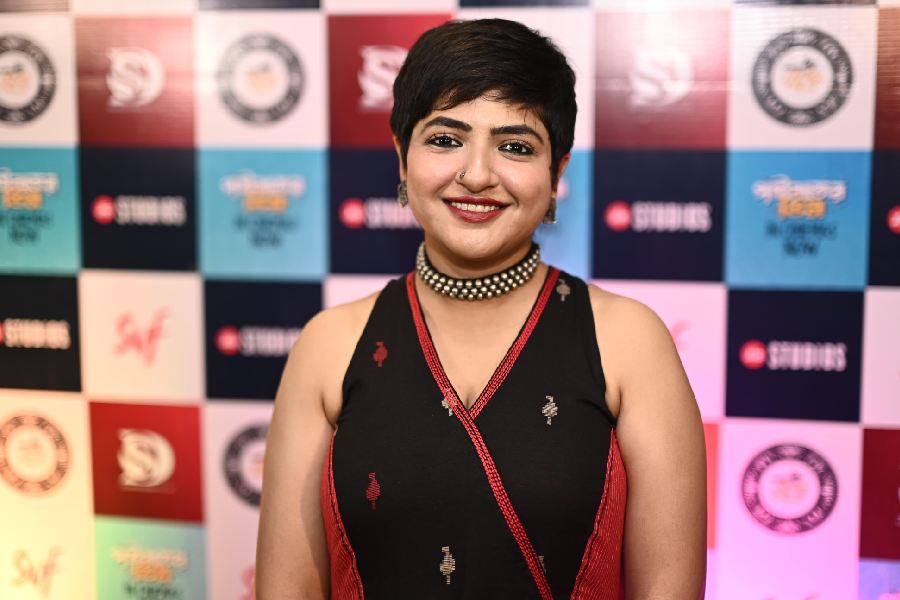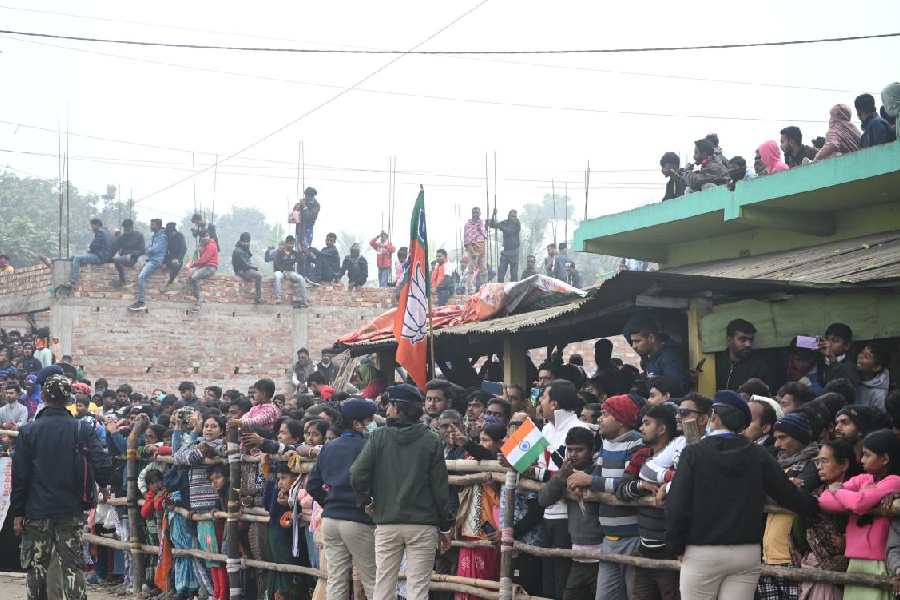 |
Youth comes but once in a lifetime, said Henry Wadsworth Longfellow. Clearly, the American poet wrote that before the era of Botox, collagen and alpha-hydroxy-acids. For in a world dominated by people over 35, staying young has become a global obsession. And gone are the days when a bottle of Godrej hairdye in the bathroom cabinet was enough to conceal your years. Today, staying young is also about maintaining a flawless skin, body and living a healthy lifestyle that includes daily gym sessions, trekking and perhaps, even running the Marathon.
It?s this addiction to youth which cosmetic and drug companies are looking at to plump up bottomlines. Consider this: In February, a controversial new anti-ageing pill called Protandim is set for release in the US. This drug?s makers say it gets the body to harness its own antioxidant enzymes to delay ageing. Some doctors say it will make you live till 120.
That remains to be seen, but the age-busting market is already red hot. There are rare berry juices to special fruit diets and Botox to Collagen treatments. If that isn?t enough, there are also spin-cycling (an exercise machine) centres where clients pedal their way back to their youthful forms, specialised multivitamin formulas, Ginseng-enriched capsules and many other youth potions.
Says Mitali Chowhan, vice-president, TNS India, a leading market research company, ?We saw the germs of this trend about a decade ago with speciality cosmetics like anti-wrinkle creams and hair colours. Now there are products in almost all genres that claim to fight age.? Today?s generation believes the battle against age can be fought ? and won. ?Also, there?s an awareness of wellness products ? the right exercise, supplements and medical treatments. People realise these are effective and can be used to arrest ageing,? adds Chowhan.
Little wonder then marketers globally predict an ?Anti-Ageing and Wellness? revolution by 2008. The revolution has already speeded up in the US, where thanks to the baby boomers ? let?s face it that they aren?t babies any more ? the anti-ageing market has exploded and is pegged to grow to a whopping $56 billion by 2008.
India is not far behind. According to market analysts, the anti-ageing market in India is estimated at Rs 3,000 crore, but with growing awareness and lifestyle changes, that figure could grow exponentially in the next two years. And like the US market, in India too, the revolution will be spearheaded by five prime categories: cosmetic treatments and surgery, exercise and therapy, food and beverages, vitamin, minerals and supplements and of course cosmetics and cosmeceuticals. For the uninitiated, those are cosmetics with drug-like effects.
Why the growing obsession with youth? Says sociologist Yogendra Singh, ?Today, there is a breakdown of the Vedic stages of life. Previously, parenthood meant you had left behind Brahmacharya and moved on to Grihasti and grandparenthood would mean you renounce materialism. Now there?s the desire to prolong youth and its pleasures. The fact there?s more disposable income only helps to reinforce this passion.?
There?s also a growing trend among people to delay marriage and parenthood, probably due to the greater focus on careers. It?s no more considered ?late? to have children after 30, 35 or even 40. With icons like Madonna who had her kids post 42, age is not such a criterion for parenthood anymore. And remember actress Demi Moore who has spent a reported $1 million to look 20 at 40? Money, too, is no deterrent at least for the well-heeled.
Explains Singh, ?Once this generation starts having children, there?ll be an increased demand to look younger. After all, you don?t want to look 50 when you take your five-year-old to kindergarten? ? even if you are.
And now you don?t have to if you don?t want to. Today?s market is spoilt for choice when it comes to age-fighting weapons. It was the Rs 2,500 crore cosmetics market that took a lead in this age-defying marathon with anti-wrinkle creams, under-eye gels and cellulite-fighting ?lotions?.
Now, it?s the cosmetic treatment and surgery segment that is likely to see a frenzy of activity in the coming years. Botox, the magic potion from the West already has a strong footing in society?s glamour circuit. The Botox company which set up shop in India a decade ago for its pharma products, is now going all out with its anti-ageing drug Botox. Says a company representative, ?In the last one year, we have seen a 50 per cent rise in usage. Today, we have more than 20 doctors in all the major cities treating patients with Botox.?
 |
Botox, a refined version of the botulinum toxin, is used to smoothen wrinkles around the eyes, nose, mouth and chin. Basically, an injection of the drug paralyses the muscle and thus smoothens the skin over it. Says Dr Arun Kumar Prasad, dermatologist, Nova Centre for Cosmetic Laser, Dermatology and Plastic Surgery, ?Quite a number of older women nowadays are looking at improving skin texture and skin colour. Many of them also want to erase fine wrinkles and fill up the age-related deep grooves between the nose and the mouth.?
Seeing the growing trend among the Indian population to look younger, Botox is planning to get aggressive in its marketing. The company plans to get celebrity endorsements, send mailers to potential clients in the SEC A+ category (households with incomes over Rs 60,000) and increase awareness through the media presence.
While Dr Prasad claims that Botox is growing in popularity, he claims that another non-allergenic product called NASHA (non-animal stabilised hyaluronic acid) is fast replacing collagen as a derma filler. ?To fill up a groove or erase fine wrinkles, we need dermal fillers. We select the product depending on the place where we want to inject it and NASHA works great as it is completely non-allergenic.? However, be it Botox to smoothen wrinkles, NASHA to fill grooves or collagen to plump up the lips, the client is beginning to shed inhibitions and spend Rs 10,000 to Rs 20,000 for a pretty face. Even if the results last only upto six months.
According to Delhi-based plastic surgeon Dr R.K Seth, in the last couple of years he has seen an increasing number of men and women over 50 coming in for surgical treatments like facelifts, liposuction and tummy tucks. ?Clients are exposed to a lot of glamour thanks to TV and nobody wants to look like a granny. They are also aware of the procedures. I even get elderly women who want to pull up their breasts or reduce their sizes.?
Meanwhile, for those scared to go under the scalpel, there are options aplenty in the form of cosmeceuticals and mineral supplements that claim to delay ageing. For a start, Protandim could soon be on the market. Closer to home, companies such as The Himalaya Drug Company, Novartis and Ranbaxy are already targeting the stay-young market.
These companies have moved smartly into the lotion and potion turf. Ranbaxy promotes its mineral supplement, Revital as a food supplement that works as a stress-buster and energiser. Novartis, which launched Calcium Sandoz for women recently, is specifically targeting post-menopausal women. Himalaya too, with its Neem, Tulsi and other herbal capsules is hitting on the wellness market as most of these products are anti- oxidants, known to fight age-related issues, besides improving immunity ? another casualty of getting older.
The companies say they aren?t seeking to increase longevity but improve the quality of life. ?In a country where the average lifespan is on the rise, it?s important to reduce the discomforts of old age and also improve the overall wellness of the old,? says Ajay Balakrishna, marketing manager of Himalaya.
On similar lines, there?s a growing niche market for specialised health foods and beverages. Take for instance, Ladakh Foods, which launched its fruit juice, Leh Berry last year made from the Seabuckthorn berry grown in the Ladakh region. The company is positioning the juice as a nutritional drink and no prizes for guessing its nutritional properties: age-defiance. D.K Mittal, group chairman, Compact International, which makes Leh Berry juice says more is in store: products like sauces, jams and more flavoured juices will hit the market in the coming months.
In this anti-ageing, age- defiance drive, call it what you will, ?natural? is a key buzzword. Which explains the growing prominence of herbal cosmetics in this market. Of the total Rs 2,500 crore market, cosmeceuticals already hog about Rs 200 crore. So be it Shahnaz Husain, Blossom Kochchar or Hindustan Lever (HLL), the bet is on cosmeceuticals. Says Chowhan of TNS, ?Besides cosmetic treatments and surgery, the maximum activity is in cosmeceuticals.?
That explains the popularity of brands such as Oriflame and Garnier that sell their anti-wrinkle creams and other age-defying products pegged on natural ingredients like aloe vera and other herbs. In fact, even Lakme and Ponds, which were hitherto all-out cosmetic companies now highlight the presence of natural ingredients like peach and orange in their creams and lotions.
HLL is also hardselling its Ayush brand. Says Dhawal Buch, vice-president, HLL: ?We realise the growing market for looking good and Ayush was evolved from the premise that people today want to look younger, but want to go about it a healthy way.? Thus besides creams, lotions and other products, Ayush also has therapy centres across the country providing holistic treatments for men and women over 35.
In fact, one of the growing areas of the anti-ageing market is the fitness and wellness segment which include state-of-the art gyms, spas and therapy centres, that are mushrooming all over the country. Says Rakesh Pandey, CEO, Kaya Skin Clinic, one of the largest players in the anti-ageing market, ?Although anti-ageing is still in a nascent stage, it is growing at an alarming rate. A lot more people are aware of Botox, fillers, non-surgical face lifts and they are willing to experiment.? Kaya, which is barely two years old, is already getting a steady stream of customers. Some of its favourite treatments include the glycolic peel, a non-surgical face-lift, double-chin reduction treatment and an under-eye treatment that makes your dark circles fade away.
Adds Pandey, ?There are lots of post-30 and early-40 people visiting us with anti-ageing problems. And the male-female ratio is a good 30:70 and increasing. Ageing as a skin problem is huge, we even have 25-year-olds coming in anxious about their laugh lines and frown lines. The market is already big and is only getting bigger.?
Biting a slice of the big pie are the mushrooming fitness centres too. Already a Rs 500 crore market, the fitness and wellness industry, according to Chowhan, will see considerable activity in the coming years. Says Chowhan, ?Yoga and alternative therapies will drive this segment. In the coming years, there will be consolidation and more brands will establish themselves as chains.?
Says Kiddy Kaul, a fitness instructor with Reebok, ?Most of the clients who come to the fitness centres today are above 35. They are clear about what they want: to look younger with a perfect body. And it?s not just a women syndrome. Both men and women are equally enthusiastic about keeping fit and even at 60, they want to have an active lifestyle.? So, are you set to give Demi Moore a run for her million-dollar look?
Lead photograph by Subhendu Chaki
Product photographs by Rupinder Sharma
Model: Ruchita Jain
The person featured in the photograph is a model and has been used for illustrative purposes only











